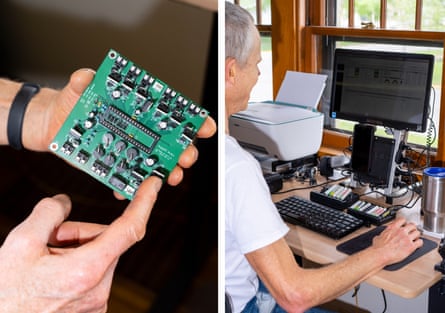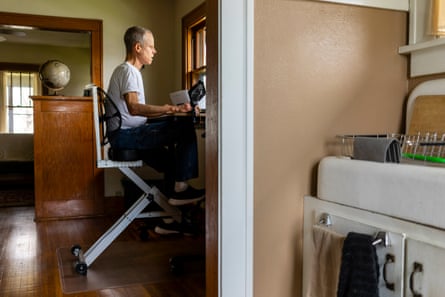I invented a pedal-powered home office. Now I exercise – and save energy – at my desk
Jim Gregory, 59, loves to cycle. More than a decade before the work-from-home revolution, the Iowa business owner was grappling with a conundrum now faced by many: how to stay active while spending so much of his day at the computer.
Jim wondered if he could combine the joy of cycling with a desire to reduce his energy consumption. Thus was born the PedalPC, a machine built from a repurposed bicycle trailer that generates enough electricity to run his computer, printer, phone chargers and home wifi.
For him, it’s been the perfect solution. Now he’s spreading the word and building them for others.
I grew up during the 1970s, a decade heavily shaped by the 1973 and 1979 oil crises. The first nearly quadrupled the price of oil, and a number of measures were subsequently taken here in the US to conserve energy. The speed limit was cut to 55 miles per hour, daylight savings time was instituted and gasoline was rationed by license plate number. My father, who rarely rode his bicycle, began commuting by bike 24 miles round trip each day. Experiencing those events made me keenly aware of how dependent we are on fossil fuels, and how bicycles can help reduce that dependence.
After I finished college, I started a bicycle-powered delivery and recycling service in Ames, Iowa. My wife and I delivered groceries, distributed free newspapers and collected recyclables using large bicycle trailers we constructed for the task. I really enjoyed the work and it gave me plenty of exercise while providing a service that benefited the environment.
Other people saw our trailers and asked if we could build trailers for them, too. So we started a side business, Bikes At Work, manufacturing bicycle trailers in our home shop and selling them over the internet. Over time, this side of our business grew while our delivery business shrank. Eventually we chose to shut down the delivery business and today we just focus on building bicycle trailers at home.

This removed the physical activity that was such a big part of my day. I now faced the problem many people have: how do you get adequate exercise each day when you work from home? I considered getting a treadmill desk or bike desk, but I didn’t find the idea appealing. I’d just be burning calories for no useful purpose. That seemed pointless and wasteful to me.
A better solution, I thought, would be to pedal a generator while I worked at my computer. The electricity generated would be clean, renewable and, unlike many other forms of renewable energy, available whenever I needed it. It would allow me to get plenty of exercise each day while making a positive impact on the environment, just like I did when I rode a bike for a living.
I didn’t find anything available on the market, so I built one for myself using some of the materials and equipment we use to build our bicycle trailers. I call my machine a PedalPC. The machine consists of a generator mounted on a stand partially resembling a recumbent exercise bike. Pedaling generates electricity, which is routed through a control box that mounts on the rear of a desk. The control box distributes the electricity through USB and 12V power outlets built into the sides of the box. To power my office equipment, I just plug each device into a power outlet and start pedaling.

If you generate more electricity than needed, the electricity is stored in a battery for use later when you’re not pedaling, so you don’t have to pedal all day to work off-grid at your desk. A small computer built into the rear of the control box records how much electricity you’re generating and each power outlet is using. It displays the results on a webpage you can view on your computer while you work. I built my first PedalPC in 2010 and have created several prototypes over the years, making improvements and adding features to each desk.
I pedal about four hours a day and generate between 200 and 250 watt-hours a day. That may not seem like much since a typical US home uses more than 100 times that much electricity, but it’s enough to power my computer, monitor, inkjet printer and desktop cooling fan, as well as charge our phones, power our fiber internet connection, provide us with wifi, charge our battery-powered LED lights and small power tools and serve the website I maintain for this project.

One reason I’m able to power so many devices is that physically generating your own electricity makes you hyper-aware of how much energy you use. You choose very energy-efficient equipment as a result. And an unexpected benefit of pedaling at my desk is that it keeps me warm in the winter. This allows us to lower our thermostat and save even more energy.
I’ve demonstrated my PedalPC at our city’s annual eco fair for the past several years and the response has been very positive. Most people who have tried it were easily able to generate enough electricity to power a computer and other equipment. Two of the people liked it enough to ask me to build one for them, which I did. Our main business is building bicycle trailers, but I find the desk really useful and so eventually we might try to sell these to other people.

I really like using my PedalPC because it allows me to work comfortably at my desk, get plenty of exercise and sustainably generate all the electricity needed to run my home office. It has solved my work-from-home problem perfectly.
-
The DIY Climate Changers is a series about everyday people across the US using their own ingenuity to tackle the climate crisis in their neighborhoods, homes and backyards. If you would like to share your story, email us at [email protected]
Source: theguardian.com



